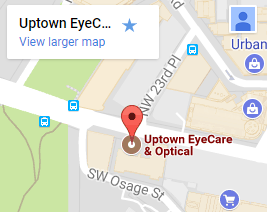Keratoconus
Keratoconus is a progressive eye disease in which the cornea thins and bulges into a cone-like shape, losing its roundness. The eventual cone shape deflects light which enters the eye towards the light-sensitive retina. The result is distorted vision.
Keratoconus can occur in one or both eyes. Keratoconus is relatively rare. If it does occur the onset usually begins in the teens or early twenties.
Symptoms of Keratoconus
Keratoconus may be difficult to detect and it typically develops slowly with few cases proceeding rapidly. As the cornea gradually becomes irregular in shape, progressively nearsightedness and irregular astigmatism increase. This creates problems such as distorted and blurry vision. Glare and light sensitivity as well. Keratoconic patients often need prescription changes every time they visit their eye doctor.
Causes of Keratoconus
The weakening of the corneal tissue which leads to keratoconus appears to be from an imbalance of enzymes in the cornea. The enzyme imbalance makes the cornea susceptible to oxidative damage from free radicals, causing weakness and corneal bulge.
Risk factors for this type of oxidative damage and weakening of the cornea include genetic predisposition, which explaining why keratoconus often affects multiple members of the same family. Keratoconus is also connected to ultraviolet (sun) overexposure, excessive eye rubbing, a history of poorly fit contact lenses along with chronic eye irritation.
Keratoconus Treatment
For mild forms, eyeglasses or soft contact lenses help. As the severity of the disease progresses and the cornea thins and increasingly distorted shape, glasses or soft contacts will no longer provide adequate vision correction.
Learn more about treating Keratoconus here.
Pellucid Marginal Degeneration
PMD is a degenerative corneal condition, often confused with keratoconus. It is typically characterized by a clear, bilateral thinning (ectasia) in the inferior and peripheral region of the cornea, although some cases affect only one eye. The cause of the disease remains unclear.
Symptoms of PMD
Pain is not typically present in pellucid marginal degeneration, and aside from vision loss, no symptoms accompany the condition. However, in rare cases, PMD may present with sudden onset vision loss and excruciating eye pain, which occurs if the thinning of the cornea leads to perforation.
PMD Treatment
Most patients can be treated non-surgically with eyeglasses, or contact lenses.The early stages of pellucid marginal degeneration may also be managed with soft contact lenses. Success has been shown with the use of rigid gas permeable contact lenses combined with over-refraction.
New studies found that the use of Scleral contact lens, a type of rigid gas permeable (RGP) lens, may be a good option for most patients with PMD. The larger RGP lens design will in most cases be more comfortable then standard rigid corneal lenses, and at times more comfortable than soft lenses. The benefit to the scleral design and the correction of eye disorders such as pellucid marginal degeneration is that vision with these types of lenses is exceptional when fit correctly.



